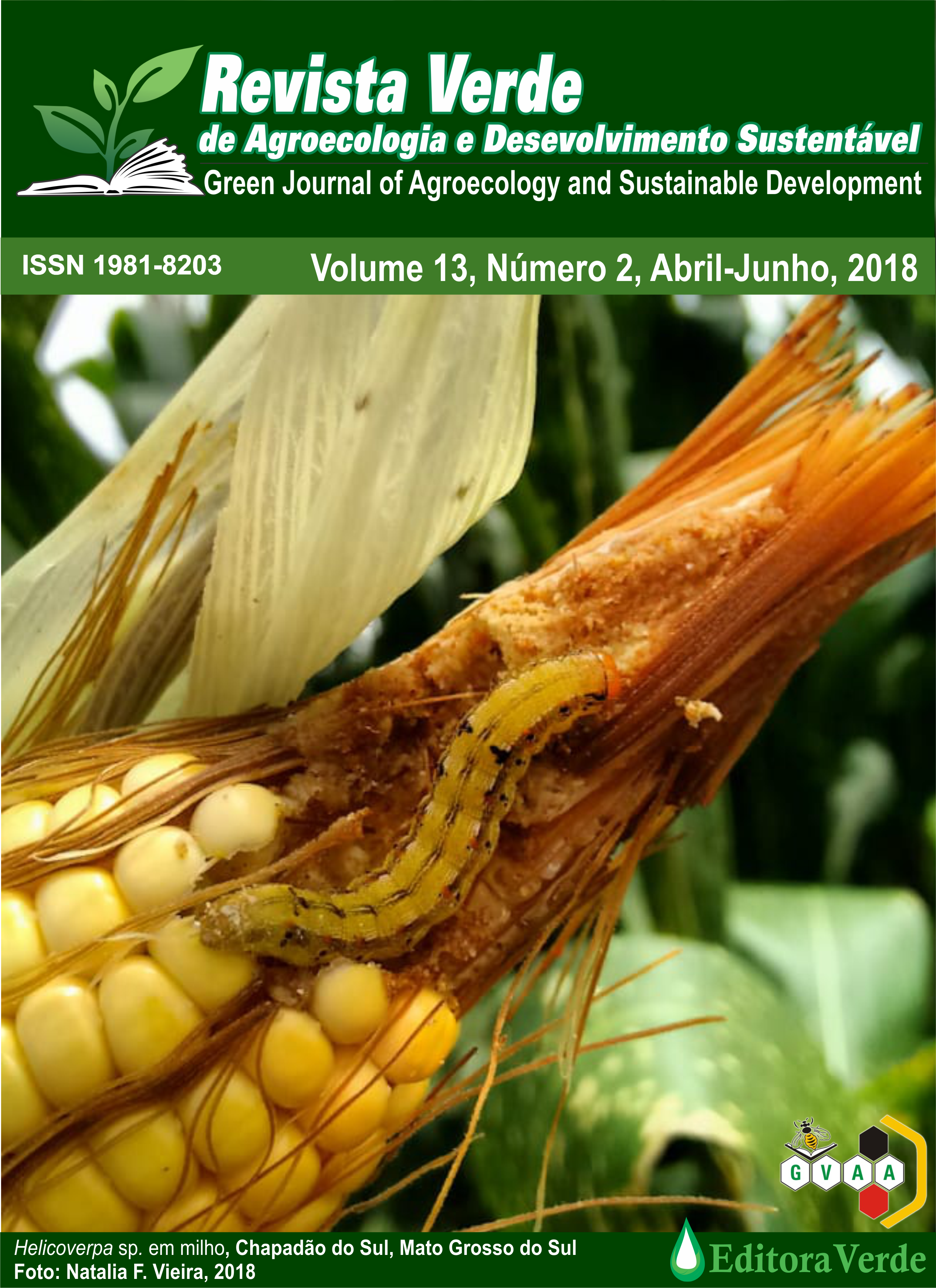Overcoming dormancy in seeds of Sapindus saponaria L. (Sapindaceae)
DOI:
https://doi.org/10.18378/rvads.v13i2.5286Keywords:
Forest seeds, Pre-germinating treatments, Soap dish, Waterproof tegumentAbstract
The Sapindus saponaria L. it is a species that possesses propagation just for seeds and her germination tax is relatively moderate the drop. Therefore, it was aimed at to evaluate different treatments pre-germinating in the overcoming dormancy of the numbness of seeds of this species. The work was driven in atmosphere protected in the Federal University of Campina Grande, in Pombal, Paraíba. The seeds were desinfested with hipoclorito to 2% for five minutes, washed in running water and submitted to the following treatments pre-germinating: intact (witnesses - T1) seeds; manual escarification with aid of sandpaper of water nº 100 on the opposite side to the micropyle (T2); chemical escarificação through the immersion in sulfuric acid to 98% Shovel, during 10, 30 and 60 minutes (T3, T4 and T5, respectively) and physical escarification through the immersion in hot water to 80 ºC for five minutes, following by thermal shock in cold water to 5 ºC for more five minutes (T6). A completely randomized design with four replicates. The seeds were submitted to the emergency tests in sand, index of emergency speed, plant height, root length, mass dries of the aerial part and of root and percentage of hard seeds. The job of the manual scarification with sandpaper of water nº 100 on the opposite side to the micropyle of the seeds is the treatment recommended by being simpler and of larger efficiency, seeking the preservation of the physiologic quality of the seeds and a better vegetative development.Downloads
References
ALVES, E. U.; BRUNO, R. L. A.; OLIVEIRA, A. P.; ALVES, A. U.; ALVES, A. U. Escarificação ácida na superação da dormência de sementes de pau ferro (Caesalpinea ferrea Mart. ex Tu. var. leiostachya Benth.). Revista Caatinga, v.22, n.1, p.37-47, 2009.
BRASIL. Ministério da Agricultura, Pecuária e Abastecimento. Regras para análise de sementes. Brasília: Mapa/ACS, 2009. 399 p.
CARVALHO, N. M.; NAKAGAWA, J. Sementes: Ciência, Tecnologia e Produção. 5ª ed. Jaboticabal: FUNEP, 2012. 590 p.
FERREIRA, D. F. Sisvar: Sistema de analise de variância. Versão 5.6. Lavras: UFLA, 2011.
GONZAGA, A. P. D.; CARVALHO, L. C. S. C.; ALMEIDA, M. S.; ROCHA, E. A.; BRAGA, R. F.; NUNES, Y. R. F. Germinação de sementes e estabelecimento de plântulas de Solanum lycocarpum St. Hill submetidas a escarificação mecânica, química e térmica. Heringeriana, v.3, n.2, p.53-65, 2009.
LIMA, J. S.; CHAVES, A. P.; MEDEIROS, M. A.; RODRIGUES, G. S. O.; BENEDITO, C. P. Métodos de superação de dormência em sementes de flamboyant (Delonix regia). Revista Verde, v.8, n.1, p.104-109, 2013.
LOVATO, L.; PELEGRINI, B. L.; RODRIGUES, J.; OLIVEIRA, A. J. B.; FERREIRA, I. C. P. Seed oil of Sapindus saponaria L. (Sapindaceae) as potential C16 to C22 fatty acids resource. Biomass and Bioenergy, v.60, n.1, p.247-251, 2014.
MAGUIRE, J. D. Speed of germination-aid in selection and evaluation for seedlig emergence and vigor. Crop Science, v.2, n.1, p.176-177, 1962.
MARQUES, C. S.; GUIMARÃES, P. V. P.; SMIDERLE, O. J.; SOUSA, R. C. P. Morfometria e crescimento inicial de Copaifera pubiflora exposta à terra vegetal produzida em compostagem. Acta Brasiliensis, v.2, n.1, p.1-5, 2018.
MELO, A. M. T.; NASCIMENTO, W. M.; FREITAS, R. A. Produção de sementes de pimenta. In: NASCIMENTO, W. M. Produção de sementes de hortaliças. Brasília: EMBRAPA, 2014. p. 169-197.
NETO, E. G. G. Participação de assimilados e acúmulo de massa seca em raízes e parte aérea de cultivares de cafeeiro em função da idade da planta. 2007. 46 f. Dissertação (Mestrado) - Curso de Fisiologia Vegetal, Universidade Federal de Lavras, Lavras, 2007. Cap. 1.
OLIVEIRA, L. M.; BRUNO, R. L. A; SILVA, K. R. G.; SILVA, V. D. M.; FERRARI, C. S.; SILVA, G. Z. Germinação e vigor de sementes de Sapindus saponaria L. submetidas a tratamentos pré-germinativos, temperaturas e substratos. Ciência Rural, v.42, n.4, p.638-644, 2012.
PAOLI, A. S.; SANTOS, M. R. O. Caracterização morfológica de frutos, sementes e plântulas de Sapindus saponaria L. (Sapindaceae). Revista Brasileira de Sementes, v.20, n.2, p.147-153, 1998.
SAMPAIO, M. F.; COUTO, S. R.; SILVA, C. A.; SILVA, A. C. A.; SILVA, A. A. S.; TEIXEIRA, A.L. Influência de diferentes substratos associados a métodos de superação de dormência na germinação e emergência de sementes de jatobá (Hymenaea courbaril L.) Revista Farociência, v. 2, n. 1, 2015.
SANTOS, P. L.; FERREIRA, R. A.; ARAGÃO, A. G.; AMARAL, L. A.; OLIVEIRA, A. S. Estabelecimento de espécies florestais nativas por meio de semeadura direta para recuperação de áreas degradadas. Revista Árvore, v.36, n.2, p.237-245, 2012.
SHINOBU-MESQUITA, C. S; BONFIM-MENDONÇA, P. S.; MOREIRA, A. L.; FERREIRA, I. C. P.; DONATTI, L.; FIORINI, A.; SVIDZINSKI, T. I. E. Cellular Structural Changes in Candida albicans Caused by the Hydroalcoholic Extract from Sapindus saponaria L. Molecules, v.20, n.5, 2015.











